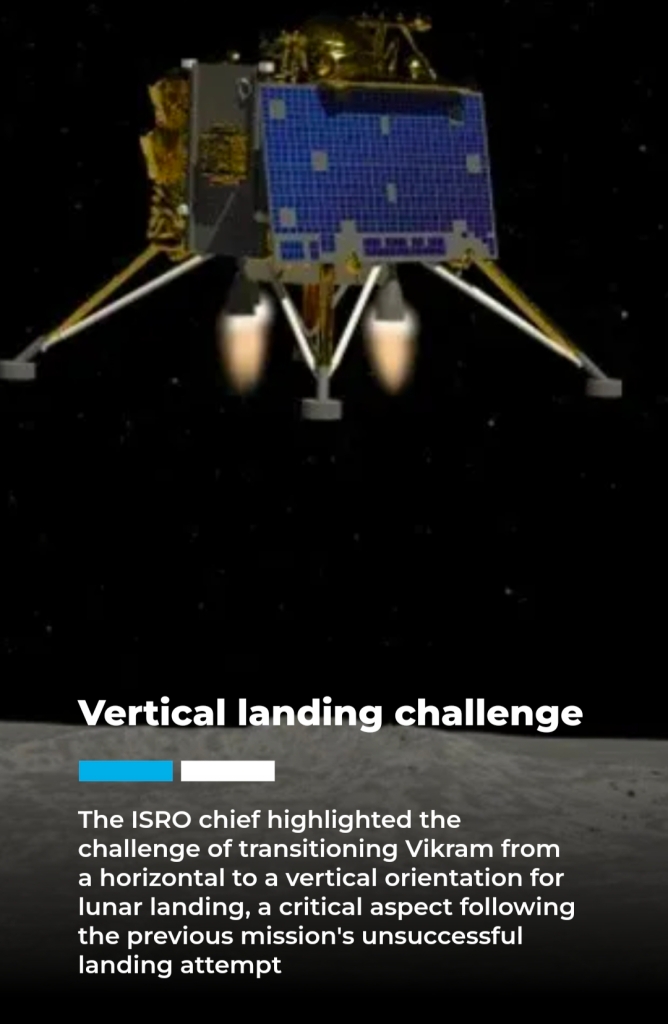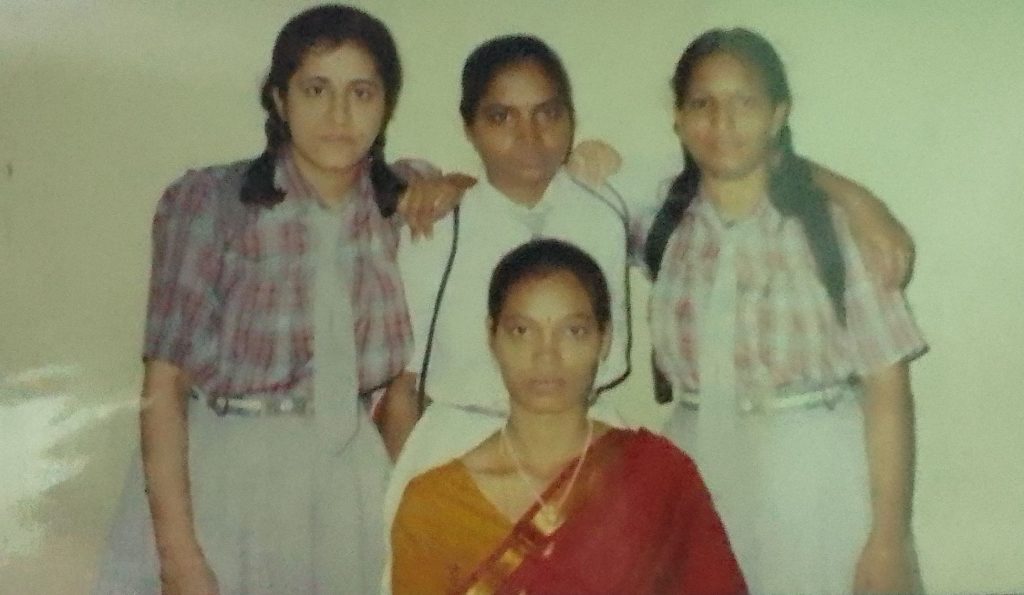“Thanks for the ride, mate ?”, had said the Lander module while bidding adieu to its companion, the Propulsion module on 17th of August and then continued alone on its journey further.

Earlier on the 15th of August, ISRO had also unveiled videos recorded by Vikram’s Lander Position Detection Camera (LPDC), providing a clear picture of the moon’s craters. Also, the Lander Imager (LI) Camera-1 captured a video offering a glimpse of Earth.
Such a proud moment, but still more to come.
????
And with the successful final de-boosting at around 2:00 a.m. on the 20th of August Chandrayaan-3’s Vikram, the Lander is now flying at a height of approx. 25 km by 37 km. in the moon’s nearest elliptical orbit.
The countdown has begun
And in less than 100 hours from now, it will attempt its much-awaited soft landing on the moon.
ISRO’s much awaited moment is coming closer every moment and Vikram is all set to make its mark on the lunar surface and make us all proud.
????

On the other hand, Russia’s much-talked-about Luna-25 has crashed on the moon’s surface after it failed to enter the pre-landing orbit and spun into an uncontrolled orbit. The spacecraft moved into an unpredictable orbit and later crash-landed on the lunar surface, announced the Russian space agency Roscosmos thus ending the country’s hopes of landing on the lunar South Pole.
This also put an end to the much-watched high profile space race that started with Russia launching its moon mission on the 10th of August and giving a tight competition to Chandrayaan-3 and putting the hopes of Indian scientists about creating history on hold, as its landing was scheduled just a day before Chandrayaan’s landing.
Chandrayaan-3 is right now flying just 25 kms. away from the moon’s nearest elliptical orbit. But the moment to cheer is still kept on hold by the scientists as they are all waiting for the Lander to touch down the surface and then after the lunar dust subsides will come out the Rover Pragyan which will then get busy performing various experiments and collecting data about this Unventured Dark Zone and harvesting the fruits of years of sincere and devoted hard work of our scientists.
As we had discussed earlier that the Sun hovers just above or below the horizon in this zone with temperatures ranging from 54°s during sunlit periods to -230°s during dark periods and even during period of illumination, some craters remain permanently shadowed and haven’t seen sunlight for billions of years hence even advanced sensors cannot capture in reality what the ground conditions are like, hence a mission that lands and studies the soil conditions was dreamt by our scientists.
In this series, Chandrayaan-1 was intentionally designed for a controlled hard landing and it discovered the presence of water molecules in the form of ice.
Chandrayaan-2 was moving ahead in the same direction but designed to soft-land but a technical glitch in the final moments led to the lander crashing on the lunar surface.
Our scientists then analyzed all the data and found out various reasons for failure and working upon all those points made necessary design changes and software changes while working on Chandrayaan-3.
So in this blog let’s discuss how Chandrayaan-3 is different from its predecessors.

Mission Chandrayaan-3 has been launched with primarily three objectives—-
– To demonstrate safe and soft landing on the lunar surface.
– Conduct Rover operations on the moon and
– Conduct in-situ experiments on the lunar surface.
Chandrayaan-3 consists of Lander Vikram, named after the great Dr. Vikram Sarabhai (father of Indian space program), Rover Pragyan meaning wisdom similar to Chandrayaan-2 and its landing site is also almost the same near the moon’s south pole at 70° s latitude, but unlike Chandrayaan-2 it doesn’t have an orbiter. Its propulsion module will rather act as a Communications Relay Satellite.
And this is the main difference between the two missions.
The reason being there wasn’t a need for an orbiter as the orbiter part of Chandrayaan-2 is still healthy with its eight scientific instruments functioning well hence Chandrayaan-3 will use the data it is providing for its mission.
This time landing is also being considered safe because the area chosen has been accurately mapped with Chandrayaan-2’s orbiter camera (OHRC).
The prime landing site is also fixed at 4 km. by 2.4 km. as against 500 mts. by 500 mts. in Chandrayaan-2.
The total fuel capacity of the rocket is 27000 kg! Both solid and liquid fuels have been used in Chandrayaan-3. The first stage uses solid fuel, the second stage uses liquid fuel whereas for the final stage a cryogenic engine is used ( It runs on liquid hydrogen and oxygen).
This propulsion module was supposed to carry the Lander upto the 100 km. Lunar orbit.
The mission duration of these components is less than or equal to one month for the Propulsion module and less than or equal to fourteen days for Vikram and Pragyan.
The weight of the Propulsion module is 2148 kg., and that of Vikram and Pragyan are 1752 kg. and 26 kg. resp.
Chandrayaan-3 is a major step towards ISRO’s future interplanetary missions but if successful it will make India the first country to land on the Lunar South Pole is what makes this mission all the more ambitious and important.
Its journey had been divided into three distinct phases viz. the Earth-centric phase, the lunar transfer phase and the moon-centric phase just like previous missions.
Chandrayaan-3 has also taken a circuitous route like its predecessors rather than the direct one to reduce the fuel requirement thus economizing the trip, hence unlike moon missions from other countries which use much bigger and heavier rockets and huge amounts of fuel to travel directly and quickly, Chandrayaan was launched using a much smaller rocket and was settled in near-Earth orbit from where it gained momentum by utilizing Earth’s gravitational force and achieve higher orbits.
The 615 crore mission carrying six scientific instruments to gather data from the surface is meant to last for half a Lunar day which is roughly equivalent to 14 Earth days since the solar panels providing electricity need sunlight which will be available for only fourteen days.
The Lander has four engines this time, to slow down its fall while landing. After it soft lands, the lander will make sure that everything is normal, and then a sort of trap door will open and guide rails will slip out and Rover will slide down these guide rails.
Both the Lander and the Rover have instruments for experiments like analyzing the lunar soil, checking the thermal conductivity of the lunar surface and the movement of quake waves through the moon.
The Lander Vikram will soft-land at the specified lunar site and deploy the six-wheeled Rover Pragyan to carry out an in-situ chemical analysis of the lunar surface.
The Rover Pragyan is like a tiny trolley with wheels that will slide out and crawl, once the Lander settles down, on the Lunar surface. It is equipped with Laser Induced Breakdown Spectroscope (LIBS) for qualitative and quantitative elemental analysis and an Alpha Particle X-Ray Spectrometer (APXS) to determine the elemental composition (Mg, Al, Si, K, Ca, Ti, Fe ) of Lunar soil and rocks around landing site so as to infer the mineralogical composition of the lunar surface.
It will pick up soil and do experiments and punch its probe about a foot down the surface to check thermal conductivity.
Then the duo will digitize the data and transmit it in the form of Electromagnetic waves to the receiver on the propulsion module and as a backup to Chnadrayaan-2’s orbiter too.
Then this data will be retransmitted back to the Earth.
In addition to these Rover payloads, the Lander payloads are Radio Anatomy of Moon Bound Hypersensitive Ionosphere and Atmosphere (RAMBHA), Chandra’s Surface Thermophysical Experiment (ChaSTE) to measure thermal conductivity and temperature, Instrument for Lunar Seismic Activity (ILSA) for measuring seismicity around the landing site, a Langmuir Probe (LP) to estimate plasma density and its variations. Along with this, a passive Laser Retroreflector Array (LRA) from NASA has also been accommodated for Lunar laser ranging studies and dynamics.
In addition to this several advanced technologies like —-
– Altimeters both Laser (LASA) and RF based,
– Velocity Meters : Laser Doppler Velocity Meter (LDV) and Lander Horizontal Velocity Camera (LHVC),
– Inertial measurement: Laser Gyro-based Inertial Referencing and Accelerometer Package (LIRAP),
– Propulsion system consisting of 800 N Throttleable Engine Control Electronics
– Navigation, Guidance, and Control (NGC) for Powered Descent Trajectory design and associated software elements,
– Hazard Detection and Avoidance:: Lander Hazard Detection and Avoidance Camera (LHDAC) which will be used to coordinate with the orbiter and as well as the mission control as Lander makes its descent approach, (Chandrayaan-2 had just one such camera while Chandrayaan-3 has been fitted with two such cameras), Lander Position Detection Camera (LPDC) and Processing Algorithm
– Landing Leg Mechanism
– Microstar sensor and
– Inclinometer and Touchdown sensors
Are present in the Lander to achieve mission objectives.
And to demonstrate these technologies under Earth conditions several tests like –
– Integrated Cold test to demonstrate the performance of Integrated Sensors and Navigation performance using a helicopter as the test platform.
– Integrated Hot test to demonstrate the closed-loop performance test with sensors, actuators and NGC using tower crane as test platform and
– Lander Leg Mechanism performance test on a Lunar simulant test bed simulating different touch-down conditions.
Have been performed successfully before launch.
Another big difference is that the Chandrayaan-2 orbiter was launched with an impressive list of nine in-situ instruments but the Propulsion module of Chandrayaan-3 carries the payload – Spectro-polarimetry of HAbitable Planet Earth (SHAPE) (for analyzing the spectrum of earth from lunar orbit for future discoveries of smaller habitable planets) as the Chandrayaan-2 orbiter is still functioning well.
The data collected by SHAPE will be used to study spectro-polarimetric signatures of Earth in the near-infrared wavelength range and create a standard to recognize the habitability of exo-planets outside the Solar System.
This Propulsion Module is designed to communicate with IDSN, the Lander will communicate with IDSN and Rover, its communication with Chandrayaan-2’s orbiter has also been planned for contingency link and the Rover will communicate only with the Lander.
Though many payloads are the same as that of Chandrayaan-2, significant improvements have been made wherever required.
Definitely, anxiety is also there regarding the landing maneuver, because this is the step where we failed last time, but ISRO is hopeful of achieving it this time as they have not only corrected the faults but have added extra margins too wherever they were less and redundancy has also been provided wherever it wasn’t there.
So as the world watches, Chandrayaan-3 is quietly continuing its journey, bringing India one step closer each moment to making its mark on the moon and placing our country on track to become the fourth nation to achieve this milestone and the first to land in The Unventured Dark Zone of the moon.
????




Leave a comment